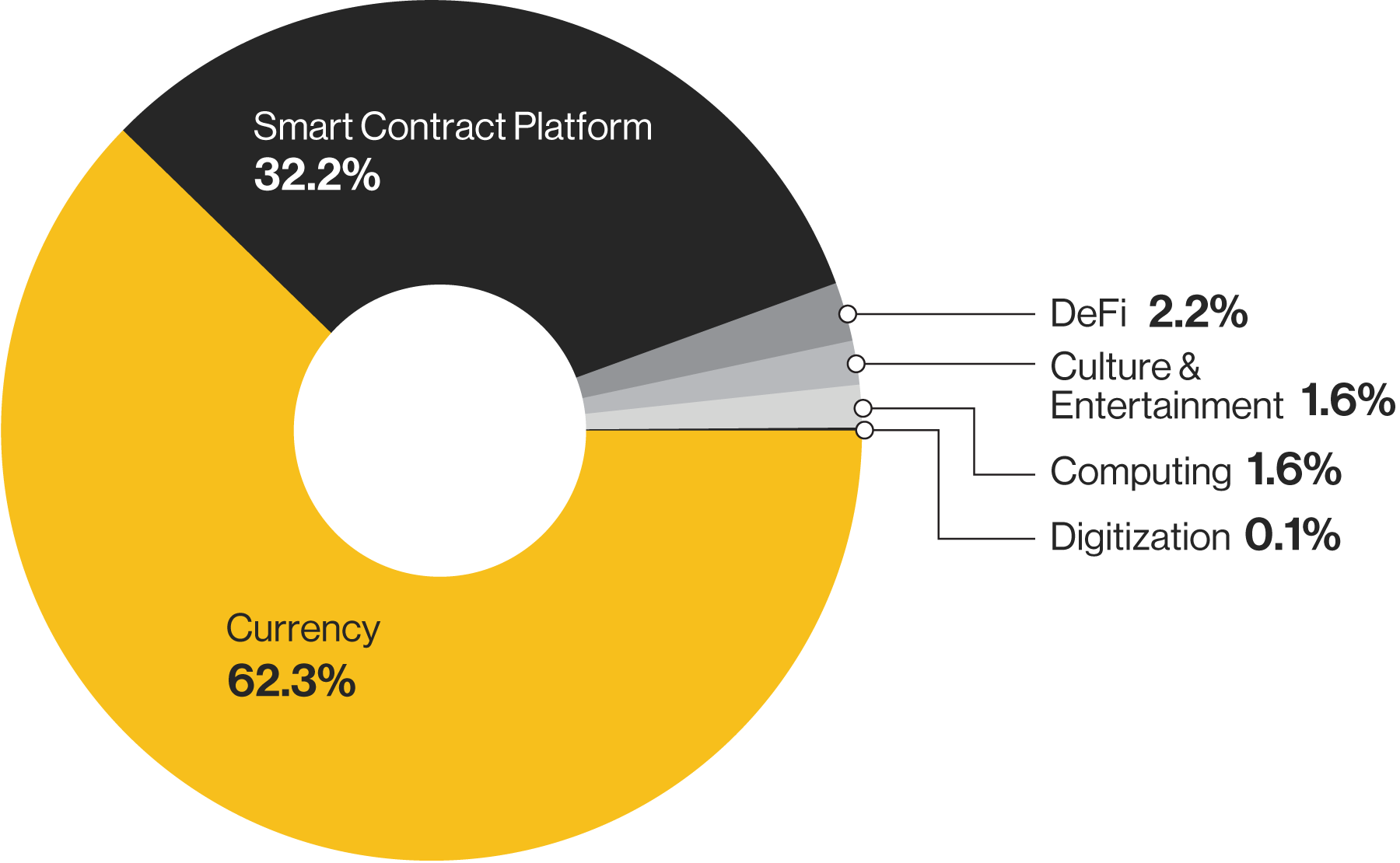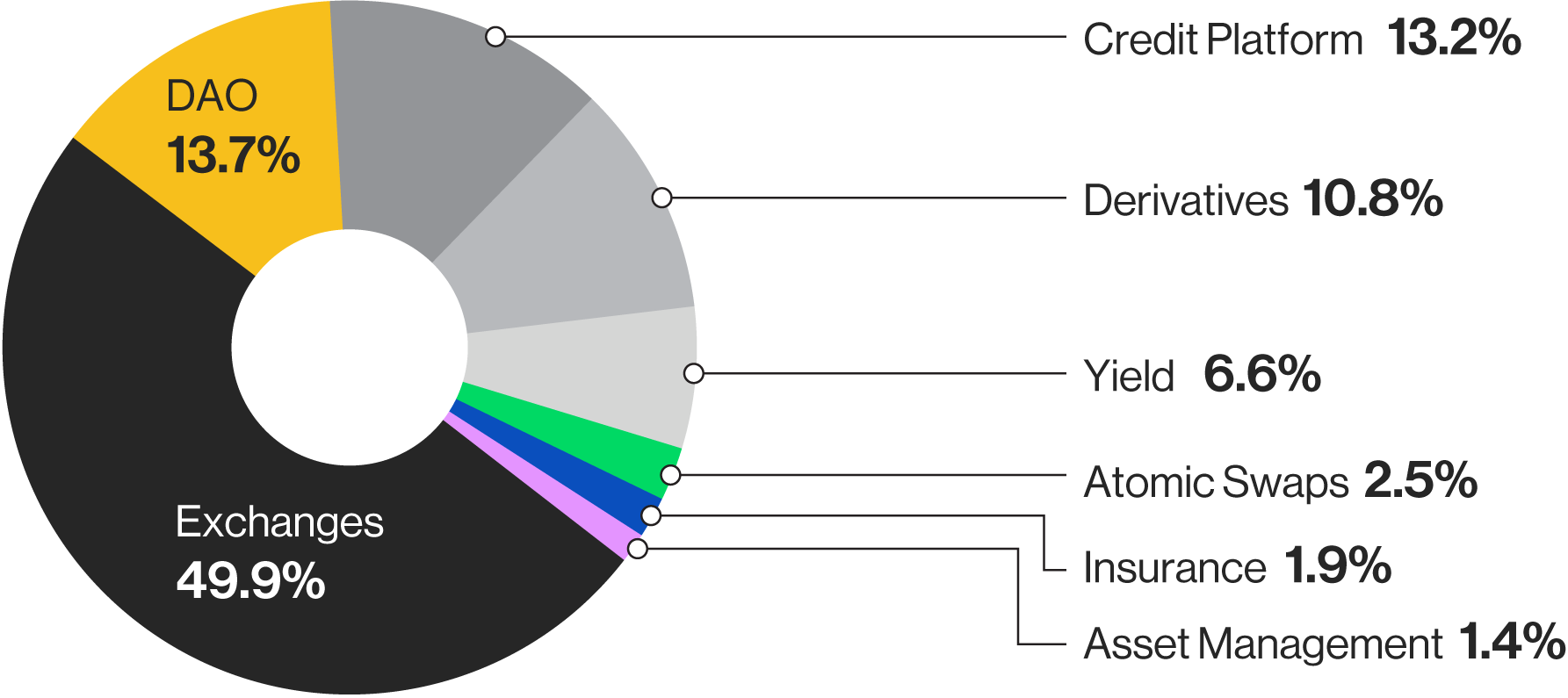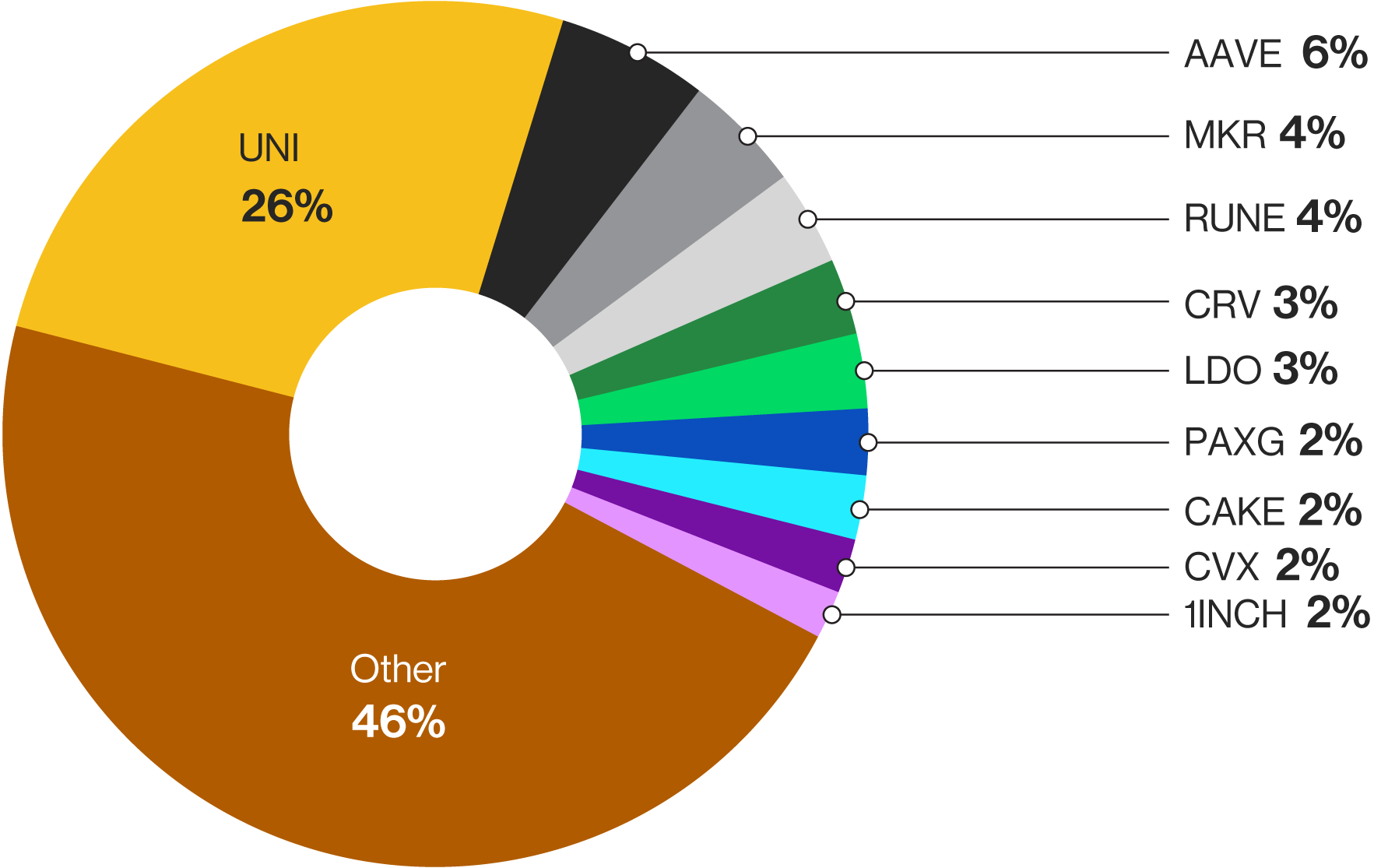Max Good, senior index research analyst at CoinDesk Indices, contributed writing for this report.
Introduction
In December 2021, CoinDesk Indices launched its Digital Asset Classification Standard (DACS) to set the standard for defining the industries of digital assets. Every one of the top 500 digital assets by market capitalization is assigned to an industry, defined by DACS, then at least one industry is assigned to an industry group. Finally, at least one industry group is assigned to a sector.
Currently, there are six sectors defined by DACS. They include Currency, Computing, DeFi (Decentralized Finance), Digitization, Culture & Entertainment and Smart Contract Platform. The DeFi sector is the third-largest sector in DACS with 111 assets representing 2.2% of the digital asset market worth approximately $24 billion in market capitalization as of July 31, 2022.
Exhibit 1: CoinDesk Indices DACS

(CoinDesk Indices, 8/15/2022. Market capitalization data is based on 7/31/2022.)
In this paper, we describe the DeFi sector in further detail by discussing its definition, constituents and the significance it holds in the broader digital asset space.
Defining the DeFi sector
Decentralized Finance, also known as DeFi, enables and empowers individuals to take control over their finances. By replacing traditional institutions with trustless, transparent and immutable code in the form of smart contracts, people can effectively be their own bank.
DeFi is powered primarily by a range of decentralized applications (dapps), all of which are openly accessible to anyone using the blockchain technology. Most traditional financial services are available in DeFi form, with innovation shaping things in this space at a rapid pace. Examples of such services include decentralized exchanges (DEX); derivatives trading, borrowing and lending platforms; asset management platforms and others. As various heterogeneous chains become more and more interoperable and interconnected, DeFi will become even more accessible and ubiquitous.
The DACS Glossary defines DeFi sector as follows:
DeFi refers to projects that support financial products and services that are not facilitated or controlled by any central entity. These financial products and services are accessible without any barrier to entry or identification requirements. All DeFi tokens must be created on smart contract platforms and offer open-sourced liquidity with the ability for token holders to reserve governance rights.
Industry groups inside the DeFi sector
The digital assets that are assigned to industries in the DeFi sector can be consolidated into eight industry groups. Within the DeFi sector, the Exchanges industry group has the most assets, currently at 33. The market capitalization of this industry group adds up to 49.9% of the sector’s market capitalization, making it the biggest of the industry groups inside DeFi. The Exchanges industry group is extremely important due to its size and its ability to contain all decentralized platforms that enable peer-to-peer and on-chain trading of various digital assets.
The Decentralized Autonomous Organization (DAO) and Credit Platform industry groups represent 13.7% and 13.2% of the sector’s market capitalization, respectively. Both industry groups share approximately the same number of assets, at 16 and 17, respectively. DAO is an industry group with a wide range of services all centered around the dynamics of a governance token. These dynamics empower their owners with voting rights over the activities of the organization. The Credit Platform industry group is somewhat more concentrated, with fewer assets and slightly bigger in size. It includes open and trustless platforms for users to deposit digital assets as collateral and subsequently borrow against those assets.
The Derivatives group comprises 10.8% of the sector’s market capitalization. Derivatives includes tokens that support options, futures, perpetual swaps, margin trading and leverage. Derivatives can also include synthetic derivatives that tokenize real-world assets.
Yield, Atomic Swaps, Insurance and Asset Management make up the bottom 6.6%, 2.5%, 1.9% and 1.4%, respectively. They are defined as follows:
● Yield includes all DeFi vaults in which depositors can stake assets in a yield-bearing vault that aggregates a positive yield from various DeFi platforms and assets.
● Atomic Swaps are a form of peer-to-peer, cross-chain transfer. With the help of a trustless smart contract acting as intermediary, two parties on two different chains can exchange one digital asset for another.
● Insurance allows users to purchase insurance via a smart contract on digital asset-related risks.
● Asset Management consists of projects that allow any aspiring portfolio manager to create and trade a basket of digital assets that prospective investors can invest in by purchasing the tokens.
Exhibit 2: DeFi Sector Breakdown by Industry Group

(CoinDesk Indices, 8/15/2022. Market capitalization data is based on 7/31/2022.)
Exhibit 3: Industry Groups under DeFi Sector
|
Industry Group
|
Market Capitalization ($)
|
Number of Assets
|
% of Market Capitalization
|
|---|---|---|---|
|
Exchanges
|
12,068,633,153
|
33
|
49.9%
|
|
DAO
|
3,327,766,473
|
16
|
13.7%
|
|
Credit Platform
|
3,194,831,356
|
17
|
13.2%
|
|
Derivatives
|
2,618,712,036
|
16
|
10.8%
|
|
Yield
|
1,596,886,746
|
14
|
6.6%
|
|
Atomic Swaps
|
602,481,190
|
8
|
2.5%
|
|
Insurance
|
463,084,333
|
2
|
1.9%
|
|
Asset Management
|
333,159,861
|
5
|
1.4%
|
(CoinDesk Indices, 8/15/2022. Market capitalization data is based on 7/31/2022.)
Industries inside the DeFi sector
Each one of 111 digital assets inside the DeFi sector is assigned to a single industry before the industry is assigned to an industry group in the sector. There are 13 industries that feed into eight industry groups mentioned prior: Yield is the only industry assigned to the Yield industry group; AMM, Exchanges (Other) and CLOB are the three industries assigned to the Exchanges industry group; Credit Platform (Other) and Lending/Borrowing are the two industries assigned to the Credit Platform industry group. Active DAO, DAO (Other), and DAO Builder are the three industries assigned to the DAO industry group. Derivatives, Atomic Swaps, Insurance and Asset Management are the only industry groups with namesake industries.
Yield allows participants to stake digital assets and earn a passive income, either by leveraging aggregation of existing DeFi platforms or by auto-compounding passive yield earned through liquidity pools, farms or other dapps.
Within the Exchanges industry group, automated market makers (AMM) such as Uniswap utilize a user-funded liquidity pool and AMM mechanism to allow exchange between two digital assets without the need for a centralized order book. CLOB, which is short for Central Limit Order Book, allows decentralized trading backed by an order book. Exchanges (Other) is made up of all digital assets that fall into the Exchanges industry group but could not be further classified.
As of July 31, 2022, AMM is the largest industry by market capitalization under the Exchanges industry group, with 21 assets totaling $10.6 billion in market capitalization followed by Exchanges (Other) and CLOB.
Exhibit 4: Industries Under the Exchanges Industry Group
|
Industry
|
Market Capitalization ($)
|
Number of Assets
|
% of Market Capitalization
|
|---|---|---|---|
|
AMM
|
$10,621,998,433
|
21
|
87.4%
|
|
Exchanges (Other)
|
$1,203,037,015
|
9
|
9.9%
|
|
CLOB
|
$333,159,861
|
5
|
2.7%
|
(CoinDesk Indices, 8/15/2022. Market capitalization data is based on 7/31/2022.)
Within the Credit Platform industry group, the Lending/Borrowing industry is where decentralized applications provide an open and trustless platform for users to deposit digital assets as collateral and borrow against those assets. Credit platforms such as Aave use a series of smart contracts to manage rates for borrowing and lending. They can also force liquidations if a loan gets too close to a predetermined loan-to-value ratio. Credit Platform (Other) is made up of all digital assets that fall into the Credit Platform industry group but could not be further classified.
As of July 31, 2022, Lending/Borrowing was the largest industry by market capitalization under the Credit Platform industry group, with 14 assets totaling $2.7 billion in market capitalization, followed by Credit Platform (Other).
Exhibit 5: Industries Under the Credit Platform Industry Group
|
Industry
|
Market Capitalization ($)
|
Number of Assets
|
% of Market Capitalization
|
|---|---|---|---|
|
Lending / Borrowing
|
$2,686,437,407
|
14
|
84.1%
|
|
Credit Platform (Other)
|
$508,393,949
|
3
|
15.9%
|
(CoinDesk Indices, 8/15/2022. Market capitalization data is based on 7/31/2022.)
Within the DAO industry group, Active DAOs can be thought of as loose conglomerations of individuals and entities where an initial set of rules and goals is established. For example, in the case of Maker, a treasury-backed stablecoin, participants can have a say in the management of the project. DAO Builder is an industry wherein platforms are designed to help users build DAOs. DAO (Other) is made up of all digital assets that fall into the DAO industry group but could not be further classified.
As of July 31, 2022, Active DAO is the largest industry by market capitalization under the industry group, with 10 assets totaling $2.5 billion in market capitalization, followed by DAO (Other) and DAO Builder.
Exhibit 6: Industries Under the DAO Industry Group
|
Industry
|
Market Capitalization ($)
|
Number of Assets
|
% of Market Capitalization
|
|---|---|---|---|
|
Active DAO
|
$2,540,145,251
|
10
|
76.3%
|
|
DAO (Other)
|
$649,376,823
|
4
|
19.5%
|
|
DAO (Builder)
|
$138,244,399
|
2
|
4.2%
|
(CoinDesk Indices, 8/15/2022. Market capitalization data is based on 7/31/2022.)
Major assets inside the DeFi sector
There are 111 digital assets inside the DeFi sector with the top asset, uniswap (UNI), representing over a quarter of the sector, and the top ten assets representing 64% of it.
Exchanges is the largest industry group under DeFi, with 33 assets and $12.1 billion in market capitalization. Within Exchanges, UNI, RUNE, CRV, CAKE and 1INCH are ranked in the sector top 10 by market capitalization. DAO is the second-largest industry group under DeFi with 16 assets and with $3.3 billion in market capitalization. Three out of the sector’s top 10 assets belong to the DAO industry group, with MKR as the largest followed by CRV and LDO. Credit Platform has 17 assets totaling $3.2 billion in market capitalization, with AAVE being the largest of them. Derivatives has 16 assets totaling $2.6 billion in market capitalization with PAXG as the largest. Yield has 14 assets with $1.6 billion in market capitalization, with CVX being the only one in the sector top 10.
There are currently eight assets in the Atomic Swaps industry group, totaling $602 million in market capitalization; two assets in the Insurance industry group with a total market capitalization of $463 million, and five assets in the Asset Management industry group, totaling $333 million in market capitalization, although none of these assets made it to the sector top 10.
Exhibit 7: Top 10 Assets Inside the DACS DeFi Sector

(CoinDesk Indices, 8/15/2022. Market capitalization data is based on 7/31/2022.)
Conclusion
The DeFi sector is the hub for on-chain financial activity, whether in the form of exchanges between digital assets, yield farming or borrowing and lending. The sector acts as the on-ramp between traditional fiat currency and a myriad of dapps that can only be accessed on the blockchain.
DeFi serves as the front end for the digital economy with dapps responsible for the majority of on-chain transactions and activities. Their underlying technologies empower participants to take ownership of their finances and interact in unique and unprecedented ways. As DeFi dapps become more interoperable and collaborative, ecosystems begin to form and attract droves of users and developers alike. Overall, DeFi remains one of the fastest growing and evolving sectors in the digital asset space.
References
-
Uniswap (UNI) is the largest decentralized exchange (DEX) and AMM, both by market capitalization and transaction volume in the digital asset space. Uniswap uses an innovative Automated Market Maker smart contract to allow traders to swap between to digital assets without the need for an order book or centralized entity to facilitate the exchange. Originally launching on the Ethereum blockchain, Uniswap has since expanded its capabilities to Polygon and other Ethereum layer 2 blockchains including Arbitrum and Optimism.
-
Aave (AAVE) is the largest credit platform. Also built on the Ethereum blockchain, Aave’s open protocol allows users to deposit funds to lend and earn a passive yield, or alternatively they can borrow against that collateral without the need for credit approval. Aave instead uses an automatic liquidation smart contract to maintain the stability of its lending pools. Aave has since expanded its services to a number of other layer 1 and layer 2 blockchains, with billions in total value locked (TVL).
-
Maker (MKR) is a DAO and governance token on the Ethereum blockchain, whose primary purpose is to support and regulate its stablecoin, DAI. DAI is a decentralized, over-collateralized, U.S. dollar-pegged cryptocurrency. Users can generate (or borrow) DAI by depositing collateral with the platform. Maker then uses a series of smart contracts and incentive mechanisms to maintain the overall price stability of DAI, including appointing MKR holders as buyers of last resort.
Disclaimer:
CoinDesk Indices, Inc. (“CDI”) does not sponsor, endorse, sell, promote or manage any investment offered by any third party that seeks to provide an investment return based on the performance of any index.
CDI is neither an investment adviser nor a commodity trading adviser and makes no representation regarding the advisability of making an investment linked to any CDI index. CDI does not act as a fiduciary. A decision to invest in any asset linked to a CDI index should not be made in reliance on any of the statements set forth in this document or elsewhere by CDI.
All content contained or used in any CDI index (the “Content”) is owned by CDI and/or its third-party data providers and licensors, unless stated otherwise by CDI. CDI does not guarantee the accuracy, completeness, timeliness, adequacy, validity or availability of any of the Content. CDI is not responsible for any errors or omissions, regardless of the cause, in the results obtained from the use of any of the Content. CDI does not assume any obligation to update the Content following publication in any form or format.
© 2022 CoinDesk Indices, Inc. All rights reserved.







